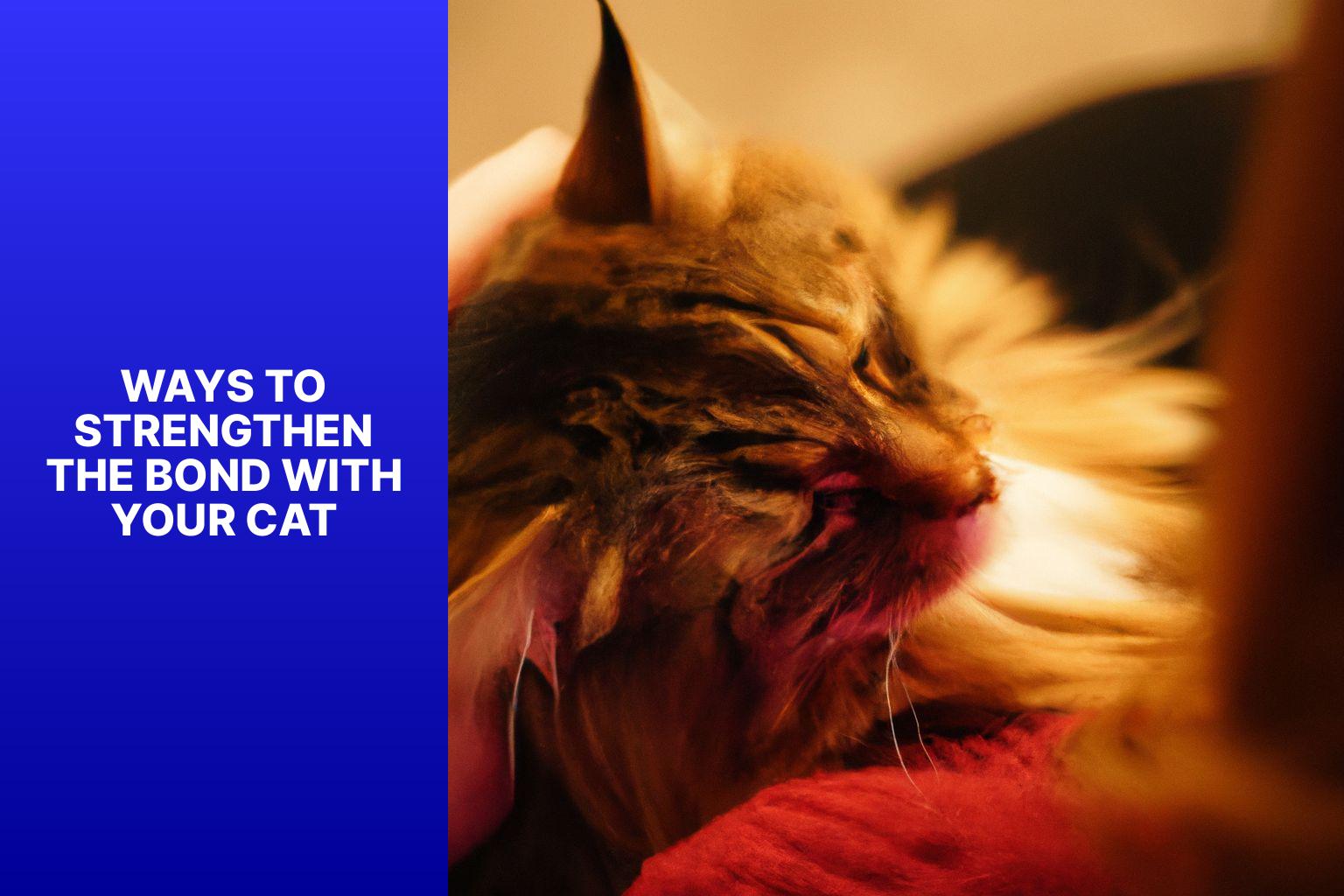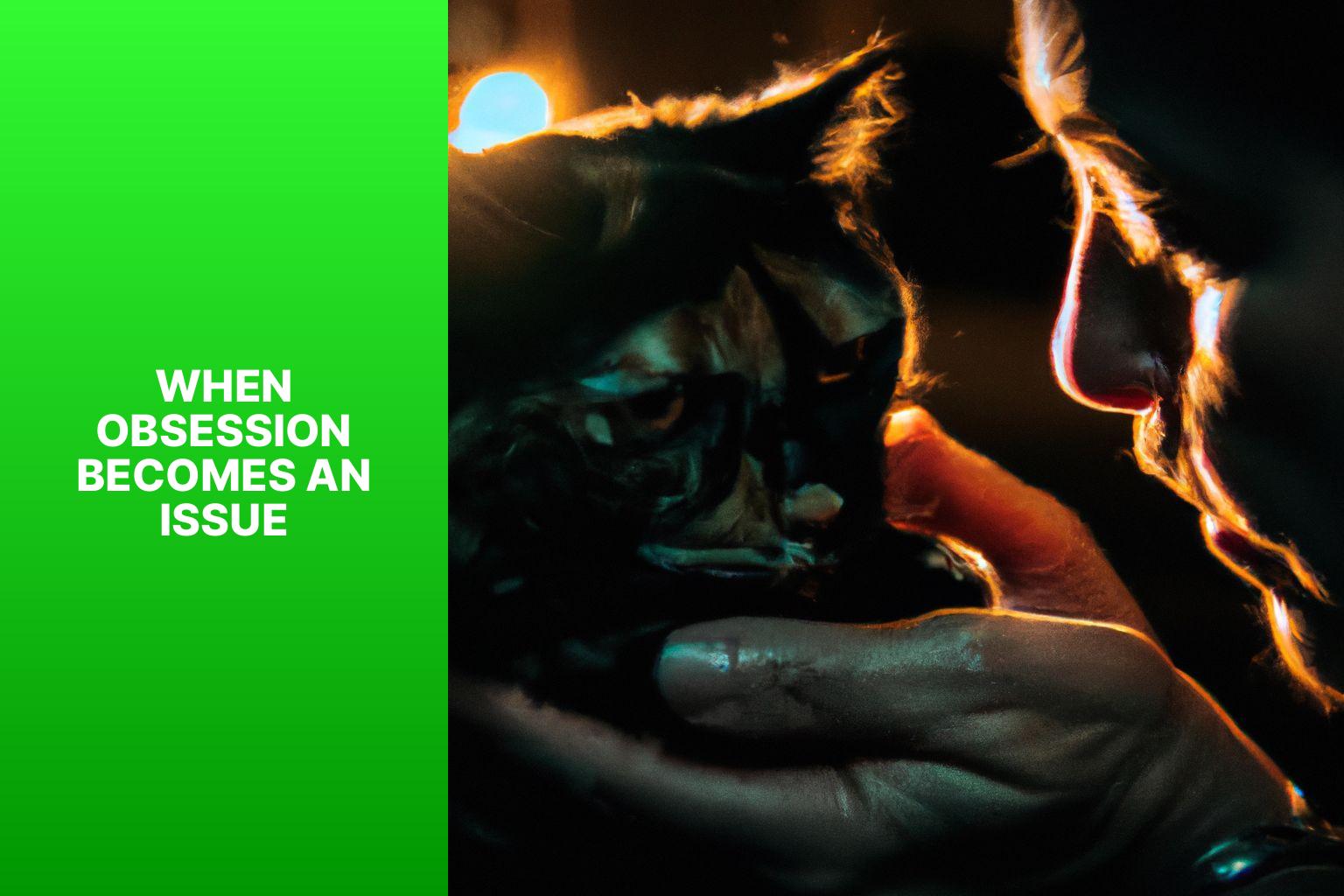Cats have a mysterious and often fascinating way of capturing our attention and affection. As cat owners, we may find ourselves pondering the reasons behind our feline friends’ seemingly obsessive behavior towards us. Understanding your cat’s behavior is key to unraveling this mystery.
When it comes to a cat’s obsession with their human companions, several factors may contribute to this attachment:
- Bonding and Attachment: Cats are capable of forming strong bonds with their owners, much like dogs, and may exhibit an obsession as a result of this close connection.
- Social Interaction and Attention: Cats are social animals that crave interaction and attention from their humans. They may become obsessed with their owners as a means to seek companionship and stimulation.
- Comfort and Security: The presence of their owner provides cats with a sense of comfort and security. They may become obsessed as they rely on their owners for emotional support.
- Scent and Familiarity: Cats have a keen sense of smell, and their obsession may stem from the familiar scent of their owner, which provides them with a sense of familiarity and safety.
There are certain signs that indicate your cat’s obsession with you, such as constantly seeking your presence, displaying excessive affection and attention-seeking behavior, following you everywhere, and vocalizing or purring when near you. These behaviors often highlight the strong bond and attachment your cat has formed towards you.
To strengthen the bond with your cat, it’s important to spend quality time together, provide enrichment and playtime, establish regular routines, and maintain a safe and comfortable environment. These practices help foster trust and deepen the connection between you and your furry companion.
There are instances when obsession can become an issue. Separation anxiety, aggression, possessiveness, and overdependence can all be signs of unhealthy obsession in cats. It’s crucial to address these issues with the help of a veterinarian or animal behaviorist to ensure your cat’s well-being and maintain a balanced and healthy relationship.
By understanding and nurturing the unique bond you share with your feline friend, you can create a harmonious and fulfilling companionship that brings joy to both of your lives.
Key takeaway:
- Understanding Your Cat’s Behavior: Knowing the reasons behind your cat’s obsession with you can help you better care for and bond with your furry friend.
- Bonding and Attachment: Your cat’s obsession with you may stem from a strong bond and attachment, as they see you as a source of love and security.
- Social Interaction and Attention: Cats crave social interaction and attention, and their obsession may be driven by their desire to be close to you and receive your affection.
Understanding Your Cat’s Behavior
Understanding Your Cat’s Behavior is important for bonding with your furry friend. Cats communicate through behavior, allowing us to comprehend their needs and emotions.
1. Body language: Pay attention to your cat’s tail position, ear position, and posture. A raised, twitching tail implies excitement, while a tucked tail signals fear or anxiety.
2. Vocalizations: Cats use different vocalizations to communicate, like meowing and purring. Each vocalization has its own meaning, so observe the context.
3. Play behavior: Playtime is crucial for a cat’s well-being. Understanding different play behaviors, like hunting and pouncing, helps enrich their environment.
4. Social interactions: Cats have unique ways of interacting with humans and animals. Some prefer independence, while others enjoy companionship. Respect their boundaries and provide socialization opportunities if desired.
5. Scratching behavior: Cats naturally scratch to maintain their claws. Provide appropriate scratching posts and redirect attention from furniture.
Remember, each cat is unique. By observing their behavior, you can meet their needs and create a harmonious environment.
Consulting a veterinarian or animal behaviorist can provide professional guidance for concerning or challenging behaviors.
Why is My Cat Obsessed with Me?
Curious why your furry friend won’t leave your side? In this exploration, we’ll uncover the reasons behind your cat’s obsession with you. From the deep bonds formed through bonding and attachment to their insatiable craving for social interaction and attention, we’ll shed light on the fascinating dynamics between cats and their owners. We’ll dive into the comfort and security they find in our presence, as well as the role of scent and familiarity in their undying devotion. Prepare to unravel the mysteries of your feline companion’s affectionate behavior.
Bonding and Attachment
Bonding and attachment between cats and their owners are crucial. Cats can form deep connections with their human companions. Here are some key factors to consider:
– Spend quality time together: Regular one-on-one time is essential for building a strong bond. Engage in interactive play sessions, grooming, or cuddling. This helps strengthen the emotional connection.
– Provide enrichment and playtime: Cats need mental and physical stimulation. Engage them in stimulating activities like interactive toys, puzzle feeders, or play areas with scratching posts and climbing trees. This fosters engagement and bonding.
– Establish regular routines: Cats thrive on routine. Set a consistent daily schedule for feeding, playtime, and other activities. This creates a sense of security and familiarity, strengthening the bond.
– Maintain a safe and comfortable environment: Ensure your cat has a stress-free environment. Provide cozy resting spots, litter boxes, and scratching posts. Pay attention to their body language for signs of discomfort or stress, and address them promptly to maintain their trust and attachment.
By following these guidelines, you can cultivate a strong bond and attachment with your cat. Understand their preferences and needs to enhance your relationship even further.
Social Interaction and Attention
Social interaction and attention are crucial in understanding why cats become obsessed with their owners. Cats are social creatures that thrive on companionship and seek attention to bond and feel secure. They may display various behaviors, such as rubbing against their owner’s legs, meowing, or pawing, to initiate social interaction. When owners respond positively by petting, playing, or talking to their cats, it strengthens their bond.
It’s important to note that some cats may become overly dependent on their owners for attention, indicating underlying issues like separation anxiety or stress. In such cases, addressing the root cause and providing appropriate support is crucial to help the cat feel more secure and confident.
For example, my cat Whiskers was obsessed with social interaction and attention. Whenever I sat down to work or watch TV, she would demand constant petting by jumping onto my lap. While it was endearing, I realized the importance of balancing attention and independence for her. By providing interactive toys and a stimulating environment, I satisfied her social needs while allowing her space to explore and play. This helped her become a happier and more well-rounded cat.
Comfort and Security
Cats seek comfort and security in their environment and relationships. Understanding this need is crucial for bonding with your cat.
1. Provide a cozy and safe space: Cats need a designated area where they can feel secure. Make sure they have access to a comfortable bed or hiding spot.
2. Establish a routine: Cats thrive on consistency. Create a daily routine for feeding, playtime, and grooming to provide security and predictability.
3. Offer hiding spots: Cats feel safe with options to hide or perch. Provide shelves, cat trees, or cardboard boxes to give them control.
4. Avoid sudden changes: Cats are sensitive to changes in their surroundings. Introduce new experiences or changes gradually to ensure they feel secure and comfortable.
5. Show affection and reassurance: Cats need physical contact and reassurance to feel safe. Gently pet them, use a soothing voice, and offer treats to cultivate comfort and security.
One heartwarming story is the tale of Smokey, a rescue cat with a traumatizing past. With time, patience, and a safe environment, Smokey learned to trust and feel secure. This demonstrates the transformative power of comfort and security in a cat’s life.
Scent and Familiarity
Cats heavily rely on their sense of scent to engage in various behaviors and interactions. The act of scent marking not only creates a sense of familiarity but also provides comfort for cats. Whenever a cat rubs against you or objects in your home, it is leaving its unique scent to mark its territory and strengthen its bond with you. Cats possess scent glands on their face, paws, and tail, which they use to mark objects and people by rubbing against them. This instinctual behavior helps them remember familiar scents and navigate their surroundings effectively. To further enhance scent and familiarity with your cat, you can actively participate in activities that promote scent exchange. For instance, providing your cat with a blanket or toy that carries your scent can offer immense comfort and reassurance in your absence. Utilizing pheromone sprays or diffusers can also contribute to creating a serene and relaxing environment for your feline companion. By understanding and respecting the significance of scent and familiarity, you can strengthen the bond and cultivate a sense of security for your beloved cat.
Signs of Your Cat’s Obsession
Curious to know if your feline friend is head over paws for you? Look no further! In this section, we’ll explore the unmistakable signs of your cat’s obsession. From constantly seeking your presence to displaying excessive affection and attention-seeking behavior, we’ll unravel the fascinating behaviors that indicate your cat’s special bond with you. Get ready to discover just how deeply your furry companion’s love and adoration for you can go. Get ready for the purrfect insight into your cat’s world!
Constantly Seeking Your Presence
Cats constantly seek your presence for multiple reasons. Cats are social animals that form strong bonds with their human companions. This constant seeking of your presence demonstrates their attachment and reliance on you.
One reason for this behavior is that your cat feels safe and secure when you are around. Your presence provides them with comfort and reassurance, particularly in unfamiliar or stressful situations. Cats also have a keen sense of smell, so your scent brings them familiarity and comfort.
Another reason is your cat’s constant need for attention and social interaction. They are curious creatures that thrive on mental and physical stimulation. By constantly seeking your presence, they express their desire for playtime, interaction, and companionship.
Some cats crave affection and closeness. They enjoy being near their favorite humans and find comfort in physical contact such as cuddling or sitting on your lap. Constantly seeking your presence may be their way of seeking comfort and love from you.
To strengthen your bond with your cat and address their constant need for your presence, spend quality time together. Engage in interactive play sessions, provide stimulating toys and activities, and establish a routine that includes dedicated bonding time. Also, create a safe and comfortable environment where your cat feels secure even when you’re not around.
It’s important to note that while constant seeking of your presence may seem endearing, monitor your cat’s behavior for signs of overdependence or stress. If their behavior becomes excessive or interferes with their daily activities, seek advice from a veterinarian or animal behaviorist.
Excessive Affection and Attention-Seeking Behavior
Excessive affection and attention-seeking behavior in cats can be frustrating, but it is important to understand the reasons behind this behavior. Cats naturally seek comfort, security, and reassurance from their human companions.
To manage this behavior, it is crucial to establish boundaries and a consistent routine. By providing designated play and attention times, you can ensure that your cat receives enough stimulation throughout the day.
Engaging in interactive play sessions and offering enrichment activities can redirect their energy in a positive way. Using positive reinforcement techniques will encourage your cat to exhibit calm and independent behavior.
Remember to reward your cat when they display desired behavior. It is also essential to fulfill your cat’s physical and emotional needs by creating a safe and comfortable environment with resting spots and scratching posts.
Consistency is key in order to minimize any potential stress or anxiety. By understanding your cat’s needs and providing appropriate outlets for affection and attention, you can create a balanced relationship.
Keep in mind that finding the right approach for both you and your cat may take some time and patience.
Following You Everywhere
When your cat follows you everywhere, it signifies a strong bond and attachment between you. Cats have a natural instinct to stay close to their preferred humans, and following you everywhere is their way of showing love and affection. It is a clear demonstration of their desire to be near you and be involved in your activities.
Cats may follow you from room to room, always staying in sight, and even shadow you while you walk or do daily tasks. This behavior not only shows their attachment, but also helps them feel secure and safe in your presence.
To strengthen your bond with your cat and encourage this behavior, spend quality time together. Engage in interactive play sessions, provide enriching toys and activities, and establish regular routines for feeding and grooming. Creating a safe and comfortable environment will also enhance their trust and encourage them to follow you everywhere.
It is important to note that excessive and overwhelming behavior of following you everywhere can be a sign of separation anxiety, stress, or overdependence. By observing your cat’s overall behavior and consulting with a veterinarian, you can address any underlying issues and ensure their well-being.
Vocalization and Purring
Vocalization and purring are natural forms of communication that cats instinctively use to express their feelings and needs. When it comes to vocalization, cats employ a range of sounds to interact with their owners, such as meowing, purring, hissing, and growling. Meowing is commonly utilized to grab attention or signify hunger, while hissing and growling serve as indications of fear or aggression.
On the other hand, purring is a delightful sound that cats produce when they are content, relaxed, or seeking attention. It acts as a soothing mechanism, conveying their well-being and desire for interaction. It’s crucial to note that cats may also purr when experiencing pain or distress, as a way to comfort themselves. Therefore, it is important to pay attention to the context in which your cat vocalizes in order to understand their needs and emotions better.
As a responsible cat owner, it is essential to respond appropriately by providing the necessary attention, fulfilling their dietary requirements, and promptly addressing any discomfort they may be experiencing. Engaging in playtime and offering comfort are additional ways to meet their needs effectively. By dedicating quality time to your cat, you can strengthen the bond between you and enhance their overall well-being.
During playtime, make use of toys and activities that stimulate both their body and mind. Offering a variety of toys, scratching posts, and interactive games will provide the mental stimulation and physical activity that cats require. Creating and maintaining a consistent schedule for feeding, playtime, and other activities can help foster a sense of security for your feline friend.
Ensuring a safe environment with cozy resting spots, clean litter boxes, and fresh water is crucial. Designating a specific safe space for privacy and relaxation will give your cat a sense of security.
Ways to Strengthen the Bond with Your Cat
Photo Credits: Www.Catcornerblog.Com by Nicholas Jackson
Looking to deepen your bond with your furry feline companion? Well, you’re in luck because we’re about to explore some fantastic ways to strengthen that special connection. From spending quality time together to providing enrichment and playtime, we’ll dive into various strategies that will have your cat purring with contentment. By establishing regular routines and maintaining a safe and comfortable environment, you’ll create a harmonious space where your cat feels loved and cherished. Get ready to take your relationship with your cat to the next level!
Spend Quality Time Together
- Engage in interactive play sessions with toys that stimulate your cat’s hunting instincts, such as wand toys or laser pointers. This exercise helps build a stronger bond between you and your cat.
- Cuddle and pet your cat, gently stroking their fur, giving chin rubs, and listening to their purrs of contentment.
- Talk to your cat using a soft and soothing tone. They may not understand the words, but they will appreciate the attention and the sound of your voice.
- Create cozy corners with blankets, pillows, or a soft cat bed where your cat can relax and observe their surroundings.
Remember, spending quality time together with your cat strengthens your bond and ensures their well-being and happiness. Set aside dedicated time each day for activities your cat enjoys.
Pro tip: Respect your cat’s boundaries and preferences. Pay attention to their body language and signals, and let them initiate or end the interaction as they desire. This fosters a trusting and respectful relationship with your furry companion.
Provide Enrichment and Playtime
Providing enrichment and playtime is crucial for maintaining a healthy and happy bond with your cat.
– Engage in interactive play sessions with your cat using toys such as feather wands or laser pointers. This stimulates their natural hunting instincts and keeps them physically active.
– Rotate your cat’s toys regularly to prevent boredom. Introducing new toys or hiding treats in puzzle toys also provides mental stimulation.
– Create a play area with scratching posts, climbing trees, and tunnels to offer exercise and exploration opportunities.
– Offer a variety of toys that cater to different play preferences, such as plush toys, balls, or catnip-filled toys.
– Set aside dedicated time each day for play and interaction to bond with your cat and establish a routine.
– Consider engaging in interactive play, such as clicker training or teaching tricks, to provide mental stimulation and strengthen the bond.
– Observe your cat’s behavior during play and adjust accordingly. Some cats may prefer short bursts of play, while others may enjoy longer sessions.
– Incorporate both active and passive play. Active play involves toys or games, while passive play includes access to window perches or bird feeders for visual stimulation.
Establish Regular Routines
Establishing regular routines is crucial for maintaining a strong bond with your cat. It is important to establish a consistent feeding schedule, providing designated playtime, creating a comfortable sleep routine, maintaining a consistent litter box routine, and spending quality time together.
1. Set a consistent feeding schedule: Feed your cat at the same time every day. This helps them feel secure and ensures proper nutrition.
2. Provide designated playtime: Set aside dedicated play sessions each day using interactive toys or engaging in activities your cat enjoys.
3. Create a comfortable sleep routine: Provide a warm and comfortable bed or blanket in a quiet area for your cat to rest undisturbed.
4. Maintain a consistent litter box routine: Clean the litter box daily and place it in a quiet and accessible location. Cats prefer a clean litter box, so sticking to a regular cleaning schedule is essential.
5. Spend quality time together: Dedicate time each day to interact with your cat one-on-one, whether through grooming, cuddling, or simply sitting together in a calm environment.
By establishing regular routines, you create stability and predictability for your cat, enhancing their well-being and strengthening the bond between you. Remember, each cat is unique, so observe and understand their preferences and adjust the routines accordingly.
True story: When I consistently followed a routine with my cat, Oscar, he became more relaxed and content. He knew when it was time to play, eat, and sleep, eagerly awaiting those activities. Our bond grew stronger as we spent quality time together following our routine. Oscar’s behavior improved, and he became more affectionate and satisfied. Routines truly work wonders in fostering a happy and harmonious relationship with your cat.
Maintain a Safe and Comfortable Environment
Maintaining a safe and comfortable environment is crucial for your cat’s well-being. Here are some key points to consider:
– Cat-proof your home: Remove potential dangers like toxic plants, chemicals, or small objects that your cat could ingest.
– Create designated spaces: Provide cozy beds, scratching posts, and hiding spots for your cat to feel safe and reduce stress.
– Ensure clean litter box hygiene: Keep the litter box accessible and odor-free.
– Maintain proper ventilation and temperature control: Keep your cat’s environment at a comfortable temperature and provide fresh air circulation.
– Offer a variety of safe and engaging toys: Regular playtime and mental stimulation are important for your cat’s well-being.
– Establish a regular feeding schedule: Feed your cat at the same time every day and provide fresh water in clean bowls.
– Encourage positive social interactions: Create a calm atmosphere for your cat to interact with family members without fear or aggression.
By maintaining a safe and comfortable environment, you are providing optimal conditions for your cat’s happiness and health.
When Obsession Becomes an Issue
Photo Credits: Www.Catcornerblog.Com by Mark Campbell
When our furry friends become a little too obsessed, it’s important to understand the potential issues that may arise. In this section, we’ll delve into the world of feline obsession and explore three key aspects: separation anxiety, aggression and possessiveness, and overdependence and stress. Get ready to uncover the reasons behind their clinginess and discover how it may affect both you and your beloved cat.
Separation Anxiety
Cats can experience separation anxiety, which causes distress when left alone. It’s important to recognize the signs of separation anxiety in your cat to address it properly.
1. Excessive vocalization and destructive behavior: Cats with separation anxiety may meow excessively, howl, scratch furniture, or urinate outside the litter box.
2. Clinginess and following: Cats with separation anxiety may become clingy and follow their owners around the house. They may display visible distress when their owners are about to leave or show signs of anxiety when alone.
3. Physical symptoms: Separation anxiety can also cause physical symptoms like excessive grooming, loss of appetite, or vomiting.
To help alleviate separation anxiety in your cat, consider the following suggestions:
1. Gradual departures and arrivals: Practice leaving and returning home in a calm and gradual way to reduce your cat’s separation anxiety. Increase the time you are away gradually, starting with a few minutes and gradually extending it.
2. Create a safe and comfortable environment: Provide your cat with a secure and comfortable space when you are away, including a cozy bed, toys, and a hiding spot to make them feel safe.
3. Environmental enrichment: Give your cat plenty of mental and physical stimulation through interactive toys, scratching posts, and playtime. This can help keep them engaged and reduce separation anxiety.
4. Seek professional help: If your cat’s separation anxiety is severe or persists despite your efforts, consult with a veterinarian or animal behaviorist for further guidance and support.
By understanding and addressing separation anxiety in your cat, you can help them feel more secure and minimize their distress when left alone.
Aggression and Possessiveness
Aggression and possessiveness are common behaviors that some cats may exhibit when they become overly obsessed with their owners. It is crucial to address and understand these behaviors in order to maintain a healthy and harmonious relationship.
Aggression: Cats that are obsessive may display aggression by biting, scratching, or hissing at their owners. This behavior is a way for them to assert control and protect their territory.
Possessiveness: Cats can also become possessive and guard their owners, belongings, or specific areas in the household. They may become hostile when approached by others.
To deal with aggression and possessiveness:
- Provide a safe space: Create designated areas where your cat can retreat to when they feel overwhelmed or possessive.
- Offer mental and physical stimulation: Engage your cat in play sessions and provide puzzle toys and scratching posts to redirect their energy and instincts.
- Establish boundaries: Use positive reinforcement to encourage desired behaviors and discourage aggressive or possessive behavior. Enforce consistent rules gently but firmly.
Did you know? A study has found that around 10-15% of cats may display aggression towards their owners at some point in their lives. Addressing these behaviors is crucial for the well-being of both you and your feline companion.
Overdependence and Stress
Overdependence and stress are common occurrences when a cat becomes overly attached to its owner. This excessive dependency can have negative repercussions for both the cat and the owner. Therefore, it is vital to address this issue to ensure the well-being of the cat.
When a cat becomes overdependent, it may display signs of distress when separated from its owner, such as excessive vocalization or destructive behavior. This separation anxiety can cause significant stress for the cat and may even result in long-term health problems.
To tackle overdependence and stress, it is important to gradually encourage the cat to be more independent. This can be achieved by increasing the amount of time that the cat spends alone, providing enrichment and stimulating toys, and fostering a sense of security in its environment.
In addition, establishing a routine for feeding, playtime, and interaction can help alleviate stress and promote stability for the cat. It is also crucial to maintain a safe and comfortable environment, free from any potential sources of stress, in order to effectively manage overdependence.
If attempts to address overdependence and stress prove to be ineffective, seeking personalized advice from a veterinarian or animal behaviorist can be beneficial. It is essential to remember that addressing overdependence and stress is crucial for the well-being of both the cat and the owner.
Some Facts About Why Is My Cat Obsessed With Me:
- ✅ Cats may become obsessed with their owners as a way to show affection.
- ✅ Some cats are naturally more affectionate and crave attention from their owners.
- ✅ Cats feel safe and secure around their owners, which can lead to obsessive behavior.
- ✅ Changes in a cat’s or their owner’s life can make a cat more clingy and obsessed.
- ✅ Cats choose their favorite person based on the time and effort spent with them, as well as how they are treated.




